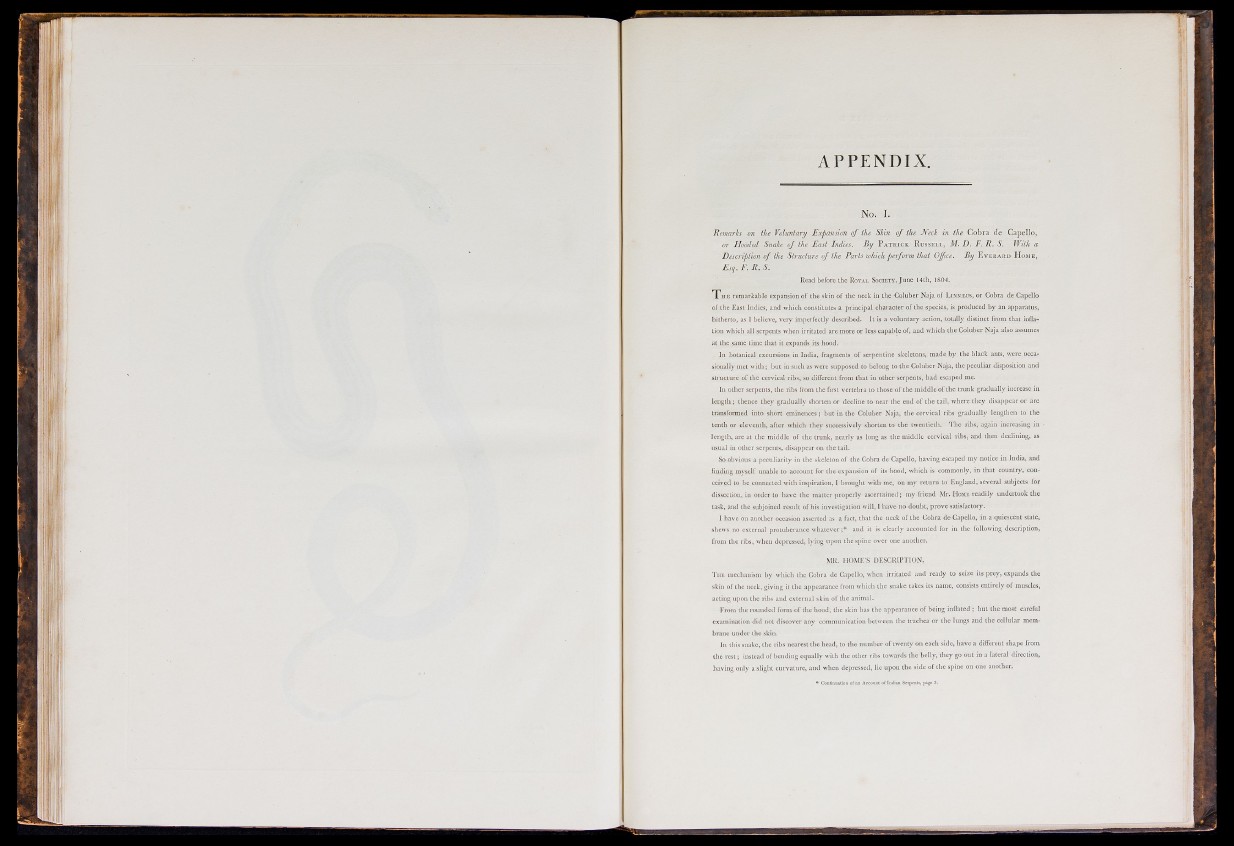
APPENDIX.
No. I.
Remarks on the Voluntary Expansion of the Slin of the Jieck in the Cobra de Capello,
or Hooded Snake oj the East Indies. BY PATRICK RUSSELL, M. D. F. R. S. With a
Description of the Structure of the Parts which perform that Office. By EVEEARD HOME,
Esq. F. R. S.
Read before the ROYAL SOCIETY, J u n e 14th, 1804.
T U E remarkable expansion of the skin of the neck in the Coluber Naja of LINNJEOS, or Cobra de Capello
of the East Indies, and which constitutes a principal character of the species, is produced by an apparatus,
h i t h e r t o , as I believe, very imperfectly described. It is a voluntary action, totally distinct from that inflat
i o n which all serpents when irritated are mor e or less capabl e of, and which the Coluber Naj a also assumes
at the same time that it expands its hood.
In botanical excursions in India, fragments of serpentine skeletons, made by the black ants, were occasionally
met wi th; but in such as wer e supposed to belong to the Coluber Naja, the pecul iar disposition and
s t r u c t u r e of the cervical ribs, so different from that in other serjients, had escaped me.
I n other serpents, the ribs from the hrst vertebra to those of the middl e of the trunk gradually increase in
l e n g t h ; thence they gradually shorten or decline to near the end of the tail, where they disappear or are
t r a n s f o r m e d into short eminences; but in the Coluber Naja, the cervical ribs gradually lengthen to the
t e n t h or eleventh, after which they successively shorten to the twentieth. The ribs, again increasing in •
l e n g t h , are at the middle of the trunk, nearly as long as the middl e cervical ribs, and then declining, as
usual in other serpents, disappear on the tail.
So obvious a pecul iari t y in the skeleton of the Cobra de Capello, having escaped my notice in India, and
finding myself unable to account for the expansion of its hood, which is commonly, in that country, conceived
to be connected with inspiration, I brought with me, on my return to England, several subjects for
dissection, in order to have the matter properly ascertained ; my friend Mr. HOME readi l y undertook the
task, and ihe subjoined result of his investigation will, I h ave no doubt , p rove satisfactoiy.
I have on another occasion asserted as a fact, that the neck of the Cobra de Capello, in a quiescent state,
shews no external protuberance whatever; * and it is clearly accounted for in the following description,
i r om the i-ibs, when depressed, l}'ing upon the spine over one another.
MR. HOME'S DESCRIPTION.
T n i ; mechanism by ii'hich the Cobra de Capello, when irritated and ready to seize its prey, expands the
skin ol' the neck, giving it the appearance f rom whi c h the snake takes its name, consists entirely of muscles,
a c t i n g upon the ribs and external skin of the animal.
F r om the rounded form of the hood, die skin has the appearance of being inflated ; but the most careful
e x a m i n a t i o n did not discover any communication between the trachea or the lungs and the cellular memb
r a n e under the skin.
I n this snake, the ribs nearest the head, to the number of twent y on each side, have a different shape from
t h e rest; instead of bending equally with the other ribs towards the belly, they go out in a lateral direction,
h a v i n g only a slight curvature, and when depressed, lie upon the side of the spine on one another.